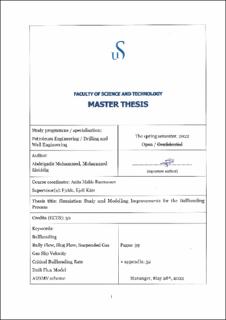| dc.description.abstract | In a bullheading operation, selecting the right pumping rate is vital to the job's success. A too low pumping rate may not displace the undesired fluid back into the formation, and a too-high rate generates high surface pressures that challenge the well equipment and the exposed formation. The optimum liquid rate for bullheading gas with liquid depends on the gas slip velocity and the gas volume fraction at the front of the gas bubble; both vary with time and depth during bullheading. Therefore, a transient model is needed to predict the flow properties and pressures at any time and depth in the well to select the pumping rate that safely injects the gas into the formation.
This study aimed to numerically simulate a bullheading process using a fully transient flow model based on the drift flux model. The first part of the study replicated the simulation of a small-scale experiment to improve its results to match the experimental results. The improvement was tested by making the kick more concentrated and reducing the numerical diffusion by increasing the number of cells in the simulation. The second part simulated a hypothetical well to study the effect of kick sizes and gas suspension in non-Newtonian fluids on bullheading. Two kick sizes were selected so that one was migrating with a bubbly flow velocity and the other was migrating with a slug flow velocity; the suspension was modeled by assuming a 10% suspended gas. In simulating the small-scale experiment, a single gas slip model was used; meanwhile, a complete gas slip model that considers bubble, slug, and suspension of gas was implemented in the well simulation.
No improvement was seen in the simulation results of the experiment. Hence the large discrepancy between the experiment and the simulation remains. However, it was observed that the critical bullheading suggested by the experiment was much higher than what one would expect for the setup of the experiment, suggesting that the reported pumping rates were probably higher than real. Therefore, this study recommends redoing the experiment and remeasuring the bullheading rates. The second part's results showed that it was easier to bullhead smaller kick sizes and kicks with suspended gas. In addition, the bullheading process was completed in a shorter time, and the surface pressure was much lower when bullheading a small kick and suspended gas kick than when bullheading a large kick with no suspended gas. | |
